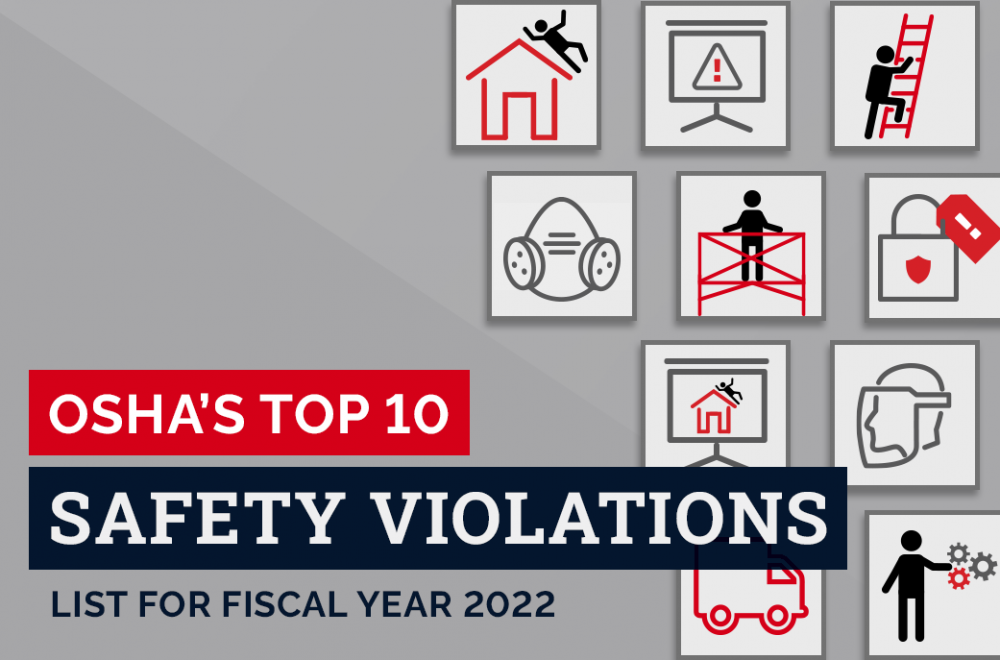The following is a list of the top 10 most frequently cited standards following inspections of worksites by federal OSHA for all industries. OSHA publishes the list to alert employers about these commonly cited standards so they can take steps to find and fix recognized hazards addressed in these and other standards before OSHA shows up. Workers suffer preventable injuries, illnesses, and deaths related to the hazards addressed in these standards.
-
Fall Protection – General Requirements (1926.501):
The most frequently violated OSHA standard is Fall Protection, which recorded 5,915 violations this year. Despite being common sense, many businesses still lack proper fall protection measures for their employees. As falls are a leading cause of workplace injuries, it is crucial to take preventive steps. Employers should educate employees working at heights of six feet or more about fall safety to comply with these standards. Ensuring structural integrity and strength of walking/working surfaces, covering floor holes, repairing deteriorating surfaces, and addressing slippery conditions are important aspects of fall protection. -
Hazard Communication (1910.1200):
The second most violated OSHA standard is Hazard Communication, with 2,639 violations. Workplaces dealing with hazardous materials must have a written hazard communication program, providing information about the chemicals’ dangers and proper handling procedures. Employers should ensure legible chemical labels and ready access to Material Safety Data Sheets (MSDS). Proper training should be given to employees to identify signs of chemical exposure. -
Ladders (1926.1053):
Industrial ladders are subject to stricter design, construction, and usage standards compared to home ladders. Ladder safety, the fourth most violated OSHA standard with 2,449 violations, is crucial to prevent injuries and fatalities. Employers should follow specific safety rules, such as using ladders on level surfaces, providing employees with manufacturer manuals on ladder usage, and adhering to proper fixed ladder angles. -
Respiratory Protection (1910.134):
Respiratory Protection ranks third in OSHA violations, recording 2,412 instances. This standard protects employees from harmful airborne particles in certain work environments. Employers should implement a written respiratory program that covers respirator selection, usage, and maintenance. Compliance with other OSHA requirements during routine and foreseeable emergencies is essential. Employers should consider appropriate respirators like air-purifying and positive-pressure respirators. -
Scaffolding (1926.451):
Scaffolding ranks fifth in OSHA violations, with 2,251 instances, indicating a lack of attention to scaffolding safety in workplaces. Employers must adhere to general scaffolding safety requirements, including capacity guidelines and qualified supervision during erection, use, dismantling, or alteration of scaffolds. Proper training for employees on scaffold use is vital. -
Lockout/Tagout (1910.147):
With 2,139 OSHA violations, the Lockout/Tagout standard is meant to protect workers from unexpected energy release during machine servicing and maintenance. Employers must ensure energy sources are isolated and locked before work begins. Proper training on lockout/tagout procedures is essential to prevent accidents. -
Powered Industrial Trucks (1910.178):
Improper use of internal combustion engine-powered trucks and forklifts resulted in 1,896 OSHA violations. Employers must provide safe usage and maintenance instruction to personnel operating these vehicles. Specific OSHA requirements cover fire protection guidelines, design, maintenance, and use of powered industrial trucks. -
Fall Protection – Training Requirements (1926.503):
1,762 companies failed to meet fall protection training requirements, emphasizing the importance of proper training for employees working at heights. OSHA has established criteria for fall protection training to reduce fall-related injuries and fatalities. Training should cover hazard recognition and actions to minimize risks. -
Personal Protective and Lifesaving Equipment–Eye and Face Protection (1926.102):
Eye and face protection are critical components of personal protective equipment (PPE). With 1,572 OSHA violations, employers must ensure that employees have appropriate eye and face protection for potential hazards, meeting comfort, stability, field of vision, durability, and compatibility requirements. -
Machine Guarding (1910.212):
Inadequate machine guarding led to over 1,469 OSHA violations. Employers must install guards to protect workers from moving machine parts, ensuring they do not cause additional hazards. Acceptable guards include barriers, tripping controls, electronic safety devices, and sensor mats, used in conjunction with other safety measures.
To improve workplace safety, employers should be diligent in implementing OSHA regulations, and workers should be vigilant about their work environment’s potential dangers. Following safety protocols and taking simple precautions can significantly reduce accidents and promote a safer work environment.
Reference osha.gov/top10citedstandards

